Fowl cholera
The fowl cholera is a by Pasteurella multocida caused disease like bacterial infectious disease of birds. In principle, all types of poultry and many wild birds are sensitive - turkeys are the most susceptible, pigeons the least susceptible . Poultry cholera is one of the notifiable animal diseases of group B in Austria .
Pathogen
The causative agent of poultry cholera is Pasteurella multocida . Capsule type A with the O-antigens 1, 3 and 4 dominates, in turkeys the capsule type F with the O-antigens 1, 3, 4, 5, 7 and 12.
Infected animals, including wild birds and rodents, play a role as a source of infection . Transmission by the leather tick Argas persicus is also possible.
Clinical picture
Fowl cholera can come in two forms.
The peracute / acute form is characterized by septicemia , which in the peracute course is characterized by sudden death, in acute fatigue, decreasing feed consumption, blue discoloration , shortness of breath and bloody nasal discharge and diarrhea. The morbidity in herds is up to 50%.
The chronic form manifests itself in runny nose, inflammation of the head appendages (comb, wattles - " lobule disease "), joint inflammation , paralysis , torticollis , balance disorders and possibly diarrhea.
treatment
The treatment of sick animals is usually unsuccessful. The therapy is therefore aimed at preventive antibiosis for endangered contact animals ( metaphylaxis ). Here sulfonamides or fluoroquinolones are used. Also penicillins are effective.
Scientific historical significance
Poultry cholera has played a prominent role in the history of medicine because Louis Pasteur used this example in 1880 to show that diseases can be prevented by vaccination . Until then, only the smallpox vaccination had been known, the functioning of which had not yet been understood. Pasteur thereby expanded the idea of vaccination into a general principle. Pasteur used the live bacteria as a vaccine. He had weakened their virulence by taking months of culture breaks during the breeding.
literature
- Rolle / Mayr (Ed.): Medical microbiology, infection and epidemic theory . Enke Verlag Stuttgart, 8th edition 2007. ISBN 3-8304-1060-3
Web links
Individual evidence
- ^ Alan Gunn, Sarah Jane Pitt: Parasitology: An Integrated Approach . John Wiley & Sons, 2012, ISBN 978-1-119-94508-6 .
- ↑ Louis Pasteur: Sur les maladies virulentes, et en particulier sur la maladie appelée vulgairement choléra des poules . In: Comptes rendus hebdomadaires des séances de l'Académie des sciences . Vol. 90, 1880, pp. 239-248.
- ^ Louis Pasteur: De l'atténuation du virus du choléra des poules . In: Comptes rendus hebdomadaires des séances de l'Académie des sciences . Vol. 91, 1880, pp. 673-680.
